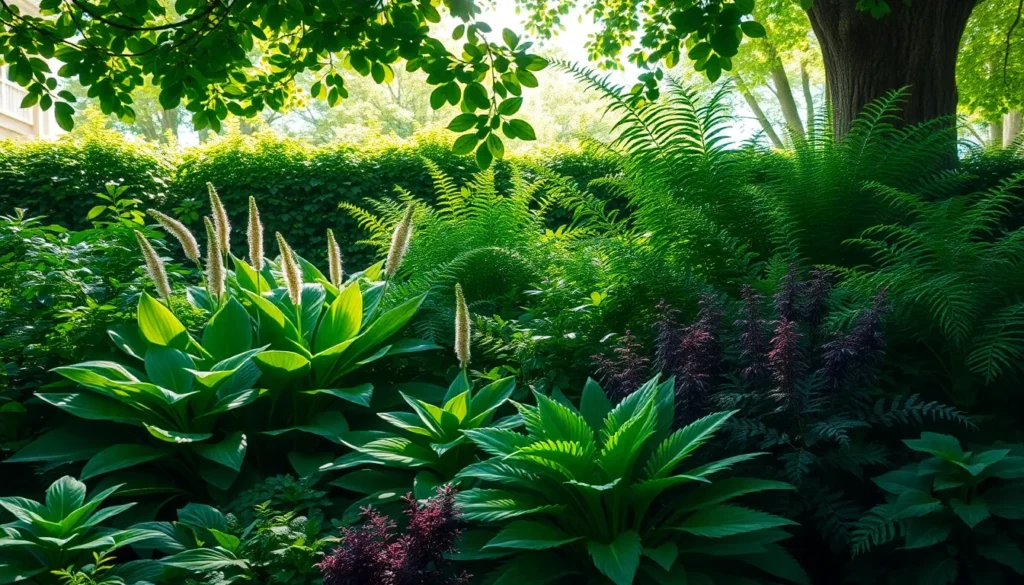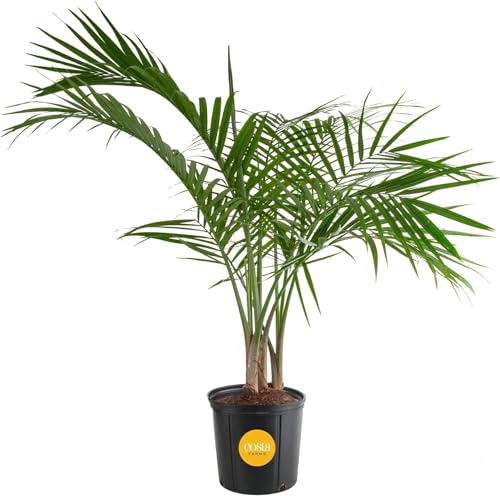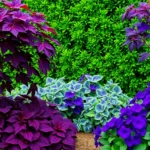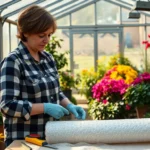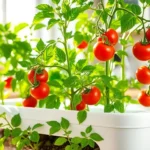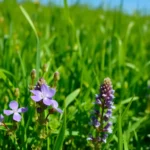We’ve all been there – staring at that shady corner of our garden wondering what could possibly thrive without direct sunlight. While most gardening advice focuses on sun-loving plants, the truth is that countless beautiful outdoor plants actually prefer or tolerate low-light conditions.
Whether you’re dealing with a north-facing yard, towering trees blocking sunlight, or narrow spaces between buildings, you don’t have to settle for bare soil. Low light outdoor plants can transform these challenging spots into lush, vibrant areas that rival any sun-drenched garden bed.
From colorful hostas to elegant ferns, we’ll explore the best shade-tolerant plants that’ll make your low-light areas the envy of every neighbor. These hardy varieties not only survive in challenging conditions – they flourish, bringing texture, color, and life to spaces you never thought could support plant growth.
Understanding Low Light Conditions in Your Outdoor Space
We need to identify what constitutes low light conditions before selecting the perfect plants for these challenging areas. Different types of shade create varying environments that support different plant varieties.
Defining Partial Shade vs Full Shade
Partial shade areas receive 3 to 6 hours of direct sunlight daily, typically during morning or late afternoon hours. These spaces often exist under deciduous trees where filtered light creates dappled patterns throughout the day. Morning sun locations tend to be gentler on plants compared to harsh afternoon exposure.
Full shade zones get less than 3 hours of direct sunlight per day and remain predominantly shadowy. Dense tree canopies, north facing walls, and areas between buildings commonly create these conditions. We find that full shade doesn’t mean complete darkness, as reflected light still provides energy for many plant species.
Deep shade represents the most challenging condition where direct sunlight never reaches the ground. Thick evergreen canopies and heavily wooded areas produce this environment. Plants in deep shade rely entirely on ambient and reflected light for photosynthesis.
Measuring Light Levels in Your Garden
We recommend using a light meter or smartphone app to accurately measure your garden’s light conditions throughout different seasons. Take readings at various times during peak growing season to get accurate assessments.
Digital light meters provide precise measurements in foot candles or lux units. Full sun registers 10,000+ foot candles, partial shade measures 2,500 to 10,000 foot candles, and full shade reads below 2,500 foot candles.
Smartphone apps like Light Meter or Sun Surveyor offer convenient alternatives for basic measurements. These tools help track light patterns over several days to account for seasonal variations.
Simple observation methods work well for basic assessments. We suggest noting how crisp shadows appear throughout the day and whether you can comfortably read a book without artificial lighting.
Common Areas Where Low Light Plants Thrive
Under mature trees creates natural shade gardens where filtered light supports diverse plant communities. Deciduous trees provide seasonal light variations that many shade plants prefer.
North facing foundations receive minimal direct sunlight but offer consistent, gentle lighting conditions. These areas stay cooler during summer months and protect plants from harsh weather.
Between buildings or structures often creates wind protected microclimates with reduced light exposure. Urban courtyards and narrow side yards fall into this category.
Covered patios and pergolas extend living spaces while providing controlled light environments. These structures create opportunities for container gardening with shade loving varieties.
Woodland edges transition from full sun to deep shade, offering multiple light conditions within small spaces. These areas support the widest variety of low light plants naturally.
Hostas: The Classic Low Light Outdoor Plants
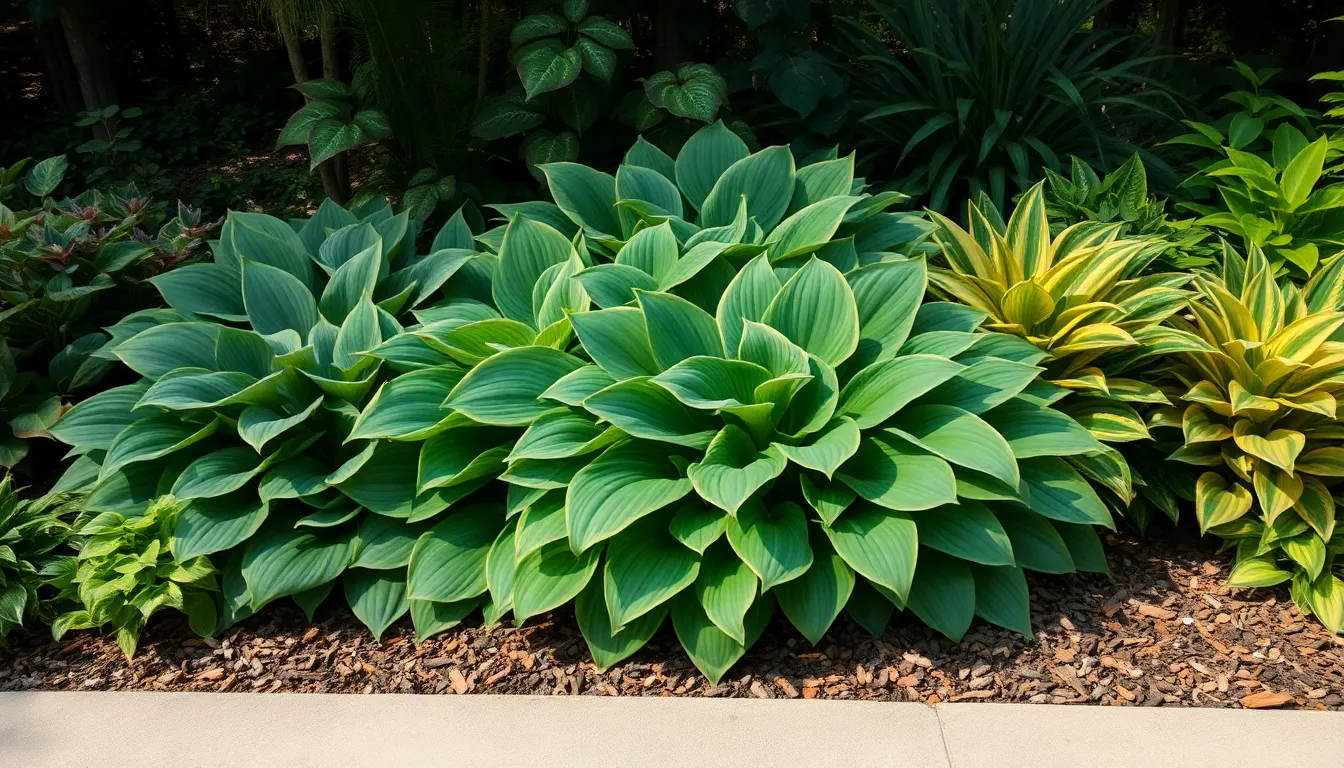
We’ve discovered that hostas reign supreme among shade loving plants, thriving in areas where other plants struggle. These perennial favorites grow from sturdy rhizomes and adapt remarkably well to various light conditions, from deep shade to partial sun exposure.
Popular Hosta Varieties for Shaded Areas
‘Golden Tiara’ stands out with its compact size and distinctive heart shaped leaves featuring medium green centers surrounded by chartreuse margins that transform to brilliant gold when touched by sunlight.
‘Patriot’ offers dramatic visual impact through its striking variegated foliage, displaying crisp white edges against deep green centers that create stunning contrast in darker garden spaces.
‘Blue’ varieties provide serene beauty with their distinctive blue green leaves that add a calming, sophisticated element to shaded landscapes while maintaining excellent performance in low light conditions.
Planting and Care Requirements
Soil preparation proves crucial for hosta success, requiring well draining, nutrient rich conditions that we can enhance by incorporating organic matter to improve both soil quality and overall plant health.
Watering consistency matters most during hot weather periods, as hostas need steady moisture levels to prevent stress and maintain their lush appearance throughout the growing season.
Sun protection becomes essential since these plants often struggle in hot afternoon sun, making partial shade locations ideal for optimal growth and foliage development.
Soil amendments prevent problems when dealing with challenging clay soils that retain too much moisture or drain poorly, creating conditions that can damage root systems.
Seasonal Interest and Foliage Colors
Color diversity ranges extensively across hosta varieties, spanning deep forest greens, distinctive blue greens, bright golds, and intricate variegated patterns that brighten shaded areas year round.
Textural variety adds depth through leaves that can be smooth and glossy, deeply ribbed for architectural interest, or beautifully puckered to create ever-changing visual appeal in garden design.
Seasonal changes provide ongoing interest as hostas maintain vibrant foliage throughout the growing season, often producing elegant white or purple flower spikes during summer months that complement their stunning leaves.
Growing season performance remains consistent from spring emergence through fall dormancy, making hostas reliable anchors for shade garden compositions that need dependable visual impact.
Astilbe: Feathery Blooms for Shaded Gardens
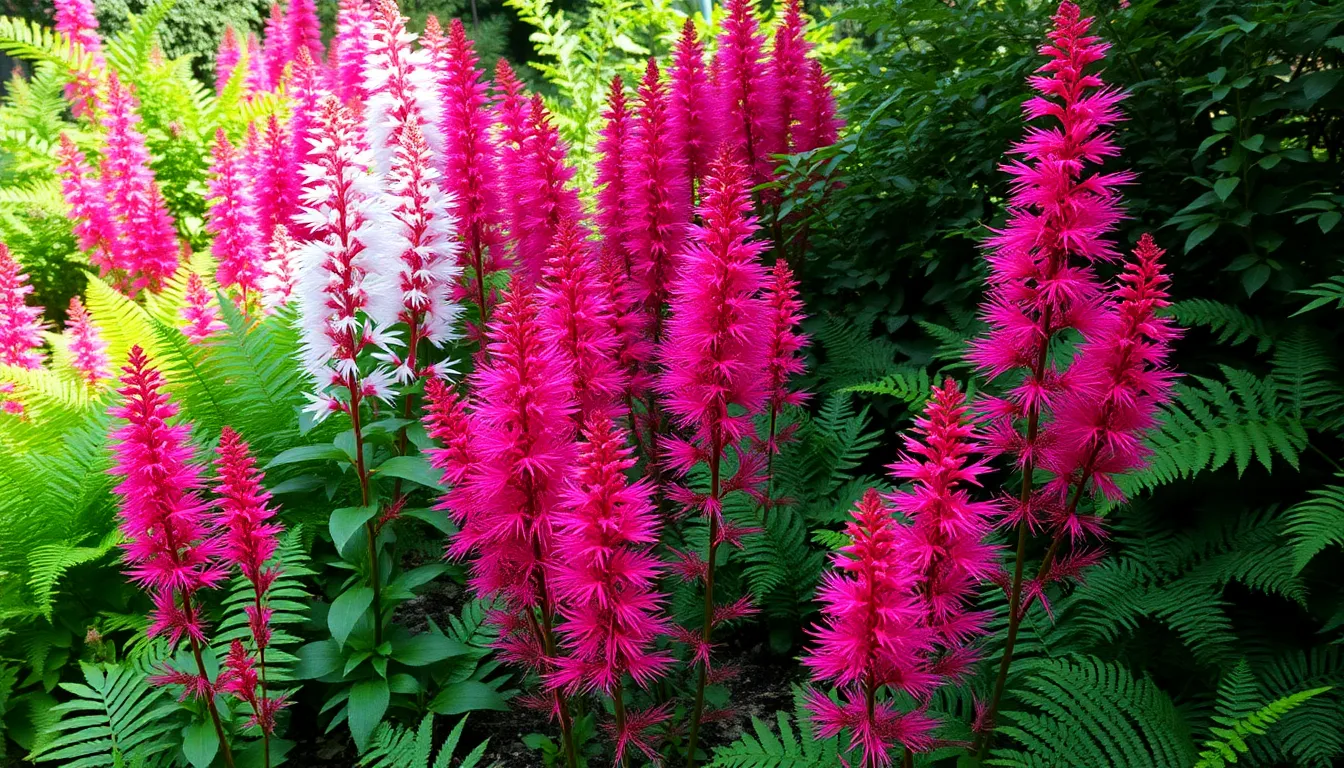
Astilbe stands out as one of the most rewarding perennials for shaded gardens, producing elegant plume-like flowers that dance above delicate foliage. We’ve found these plants particularly valuable for adding vertical interest and soft texture to areas where other flowering plants struggle.
Best Astilbe Cultivars for Low Light
‘Rheinland’ offers vibrant pink blooms that brighten the darkest corners of our gardens, reaching heights of 18 to 24 inches with excellent shade tolerance. This cultivar produces dense flower plumes in early summer and maintains attractive bronze-tinted foliage throughout the season.
‘Fanal’ delivers deep red flowers that create dramatic focal points in low light conditions, growing compactly to about 18 inches tall. We appreciate this variety’s ability to maintain its rich color intensity even in areas with minimal sunlight exposure.
‘Pumila’ provides pure white blooms perfect for illuminating deeply shaded spaces, staying petite at just 8 to 12 inches in height. This dwarf cultivar works exceptionally well as ground cover or front border plantings where space is limited.
Additional cultivars like ‘Deutschland’ and ‘Bridal Veil’ extend our white flower options, while ‘Vision in Red’ and ‘Vision in Pink’ offer newer varieties with improved heat tolerance for challenging low light environments.
Watering and Soil Preferences
Consistent moisture becomes crucial for astilbe success, as these plants prefer soil that stays evenly moist but never waterlogged. We recommend checking soil moisture regularly during dry periods and providing deep watering sessions rather than frequent shallow applications.
Well-draining soil prevents root rot while maintaining the steady moisture levels astilbe requires for optimal growth. Organic matter like compost or aged manure improves both drainage and water retention, creating ideal growing conditions.
Slightly acidic to neutral soil pH between 6.0 and 7.0 supports healthy astilbe development and vibrant flower production. We test our soil annually and amend with sulfur or lime as needed to maintain proper pH levels.
Mulching around astilbe plants helps retain moisture and suppress weeds while providing insulation for shallow root systems during temperature fluctuations.
Creating Stunning Color Combinations
Pairing astilbe with hostas creates classic shade garden combinations that offer contrasting textures and complementary growing requirements. We position larger hosta varieties behind astilbe to provide backdrop support while smaller hostas work well as foreground companions.
Heucheras add vibrant foliage colors that enhance astilbe’s subtle leaf tones, with purple and burgundy varieties creating particularly striking contrasts against white or pink astilbe blooms. These combinations thrive in similar light conditions and require comparable care routines.
Ferns provide delicate, natural textures that soften astilbe’s more structured appearance while filling gaps between plantings. Lady ferns and Japanese painted ferns complement astilbe particularly well, creating layered compositions with varying heights and forms.
Coral bells, ajuga, and lungwort extend our color palette options while maintaining the shade-loving theme throughout the garden design. We arrange these combinations to create flowing transitions between different plant groups and seasonal interest patterns.
Heuchera: Colorful Foliage Plants That Love Shade
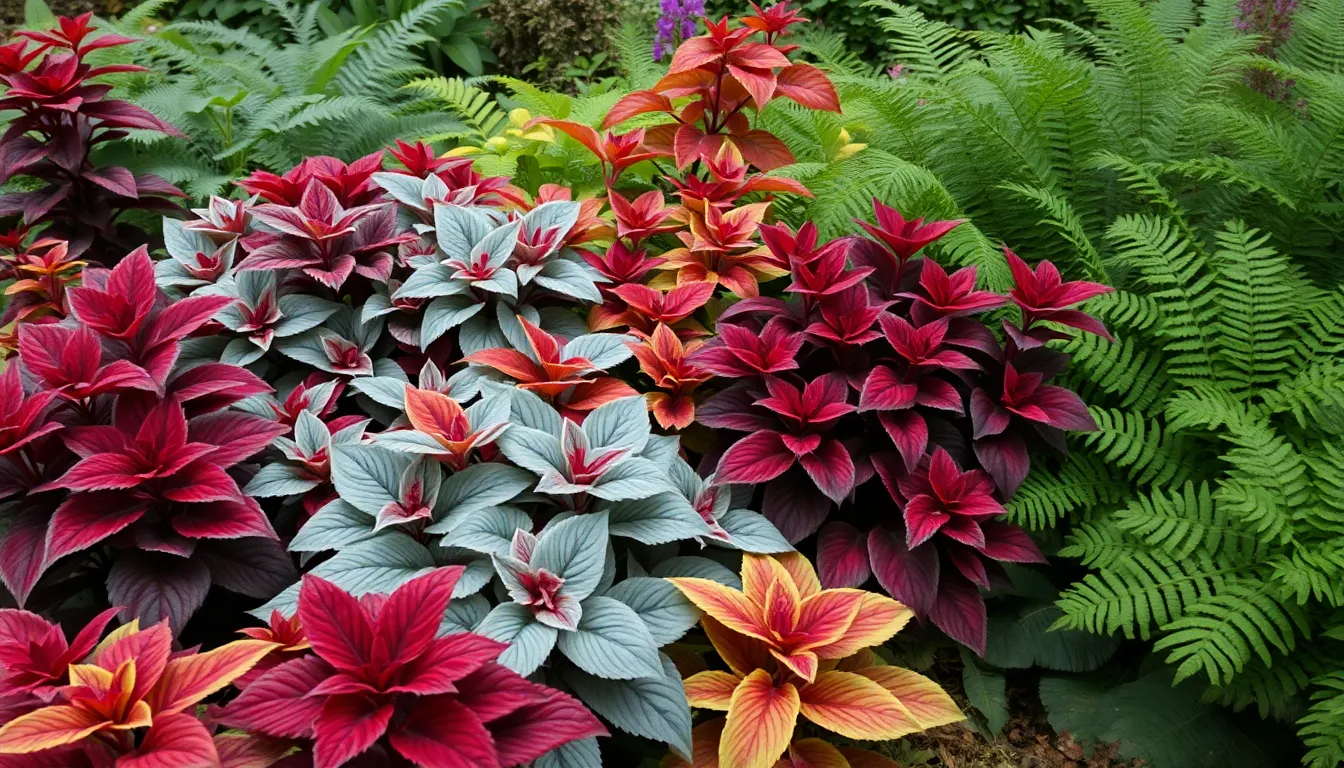
Heuchera plants bring stunning foliage color to low light outdoor spaces where many other plants struggle to thrive. We’ve found these versatile perennials, commonly known as Coral Bells, create beautiful displays in partial shade to full shade conditions throughout the growing season.
Top Coral Bell Varieties for Low Light Outdoor Plants
Heuchera ‘Plum Pudding’ stands out with its deep purple-red leaves that maintain rich color even in shadowy locations. We recommend this variety for gardeners seeking dramatic foliage that creates striking contrast against green companions.
Heuchera ‘Silver Fountain’ offers elegant silver-gray leaves that practically glow in low light conditions. This variety works exceptionally well in moon gardens or areas where you want to brighten dark corners naturally.
Heuchera ‘Crimson Curls’ provides maple-like leaves with deep red coloration that intensifies in cooler weather. We’ve observed this cultivar performs beautifully under tree canopies and along north-facing foundations.
Additional low light varieties include ‘Palace Purple’ with bronze-purple foliage, ‘Obsidian’ featuring nearly black leaves, and ‘Lime Rickey’ displaying chartreuse coloration that brightens shaded spaces.
Maintenance and Winter Care
Watering requirements focus on keeping soil consistently moist but never waterlogged, as heucheras develop root rot in soggy conditions. We water deeply once or twice weekly during dry spells, checking soil moisture at 2-inch depth.
Soil preparation involves creating well-draining conditions with slightly acidic pH between 6.0 and 7.0. We amend heavy clay soils with compost and coarse sand to improve drainage around these low light outdoor plants.
Winter protection includes mulching around the plant base with 2-3 inches of organic material like shredded leaves or bark chips. We avoid covering the crown directly to prevent moisture buildup and potential crown rot during dormant months.
Annual maintenance requires removing old flower spikes and damaged leaves in early spring before new growth emerges. We divide overcrowded clumps every 3-4 years to maintain vigor and prevent woody centers from developing.
Companion Planting Ideas
Lady Ferns complement heuchera plantings perfectly with their delicate, arching fronds that create textural contrast against broad coral bell leaves. We position these shade-loving partners 18-24 inches apart for optimal growth space.
Hostas provide excellent backdrop plants with their large, architectural leaves that highlight heuchera’s colorful foliage. We select hosta varieties like ‘Patriot’ or ‘Golden Tiara’ that share similar light requirements for cohesive low light outdoor plant combinations.
Hellebores add early spring interest to heuchera gardens with their nodding flowers that bloom before coral bells fully emerge. We plant Christmas roses nearby to extend seasonal color from late winter through fall.
Additional companions include astilbe for summer blooms, Japanese painted ferns for silver accents, and coral bells’ fellow natives like wild ginger and solomon’s seal for naturalistic woodland gardens.
Caladiums: Tropical Beauty in Low Light Conditions
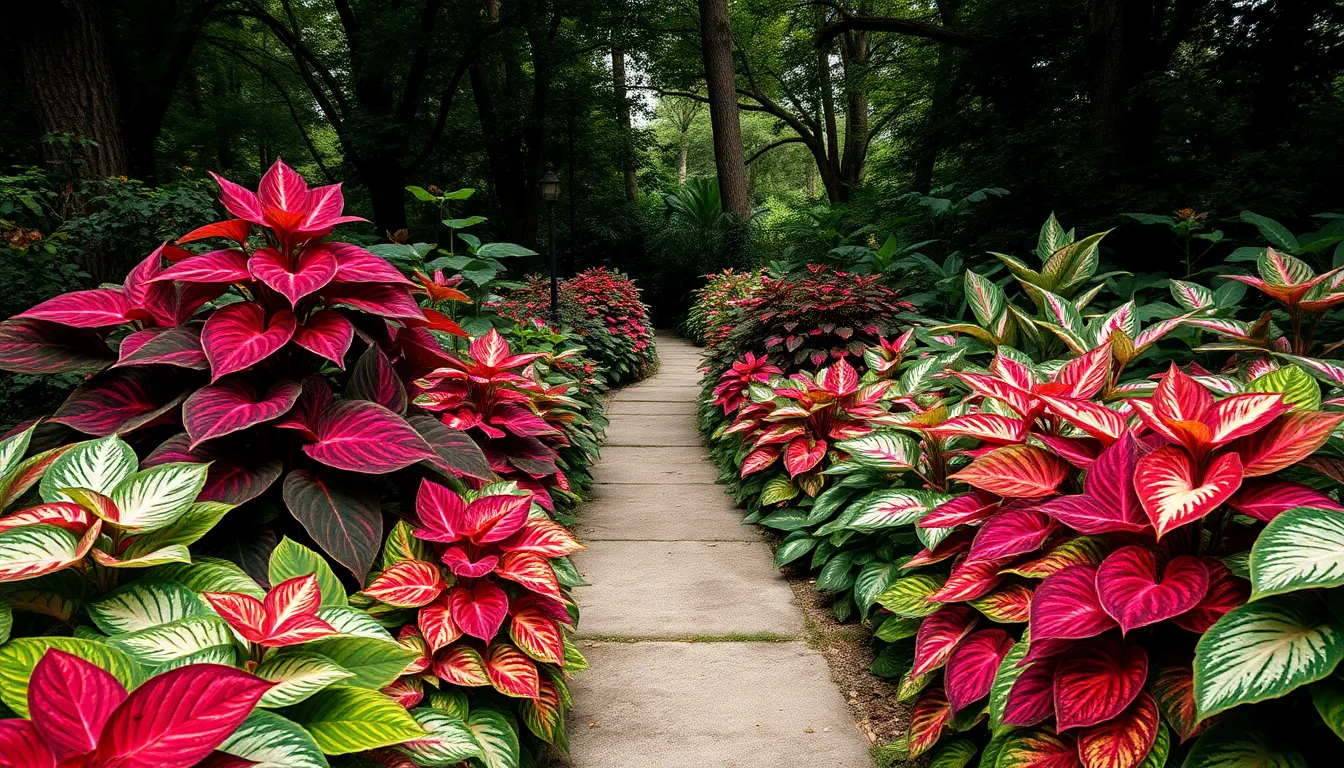
Caladiums bring vibrant, colorful leaves to shaded garden spaces where many tropical plants struggle to survive. These heat-tolerant plants thrive in low light conditions, making them perfect additions to outdoor shade gardens in warmer climates.
Heat-Tolerant Varieties for Outdoor Shade
‘Florida Sweetheart’ produces heart-shaped leaves with deep red centers and green edges, creating stunning visual contrast in shaded areas. This variety tolerates heat exceptionally well while maintaining its vibrant colors throughout the growing season.
‘White Queen’ displays large white leaves with green veins and pink blush, offering elegant beauty in low light gardens. The variety performs reliably in outdoor shade conditions and withstands summer heat better than many other caladium cultivars.
‘Red Flash’ features bright red leaves with darker red veins and green margins, adding bold color to dim garden corners. This heat-resistant variety maintains its striking appearance even during hot summer months in shaded locations.
‘Pink Beauty’ showcases soft pink leaves with green edges, providing gentle color transitions in shade garden designs. The cultivar adapts well to outdoor growing conditions and requires minimal direct sunlight to flourish.
Bulb Storage and Seasonal Care
Timing matters when harvesting caladium bulbs, as we should wait until foliage begins yellowing naturally in fall. Dig bulbs carefully after the first light frost kills the leaves, ensuring we don’t damage the tubers during removal.
Cleaning and drying involves removing soil and dead foliage from harvested bulbs before allowing them to cure. Place bulbs in a warm, well-ventilated area for 7-10 days until the outer skin becomes papery and dry.
Storage conditions require cool, dry environments with temperatures between 70-75°F for optimal bulb preservation. Store dried bulbs in mesh bags, paper bags, or cardboard boxes filled with peat moss or vermiculite to maintain proper moisture levels.
Spring preparation begins 4-6 weeks before the last expected frost when we start bulbs indoors. Plant bulbs in containers with well-draining potting mix, keeping soil consistently moist but not waterlogged until outdoor transplanting time arrives.
Design Tips for Maximum Impact
Layering textures creates visual depth by combining caladiums with different foliage plants like hostas and ferns. Mix broad caladium leaves with fine-textured companions to establish contrast and maintain interest throughout the growing season.
Color coordination works best when we select caladium varieties that complement existing shade plants in our gardens. Pair pink and white caladiums with silver heucheras, or combine red varieties with deep green hosta foliage for dramatic effect.
Seasonal succession ensures continuous color by planting caladium bulbs at 2-3 week intervals from late spring through early summer. This staggered approach provides extended blooming periods and maintains garden appeal as earlier plantings begin to fade.
Container combinations offer flexibility for shade garden design, allowing us to move caladiums to optimal viewing positions. Plant multiple varieties in large containers with consistent watering systems to create portable focal points for patios and covered outdoor spaces.
Begonias: Continuous Blooms in Shaded Spaces
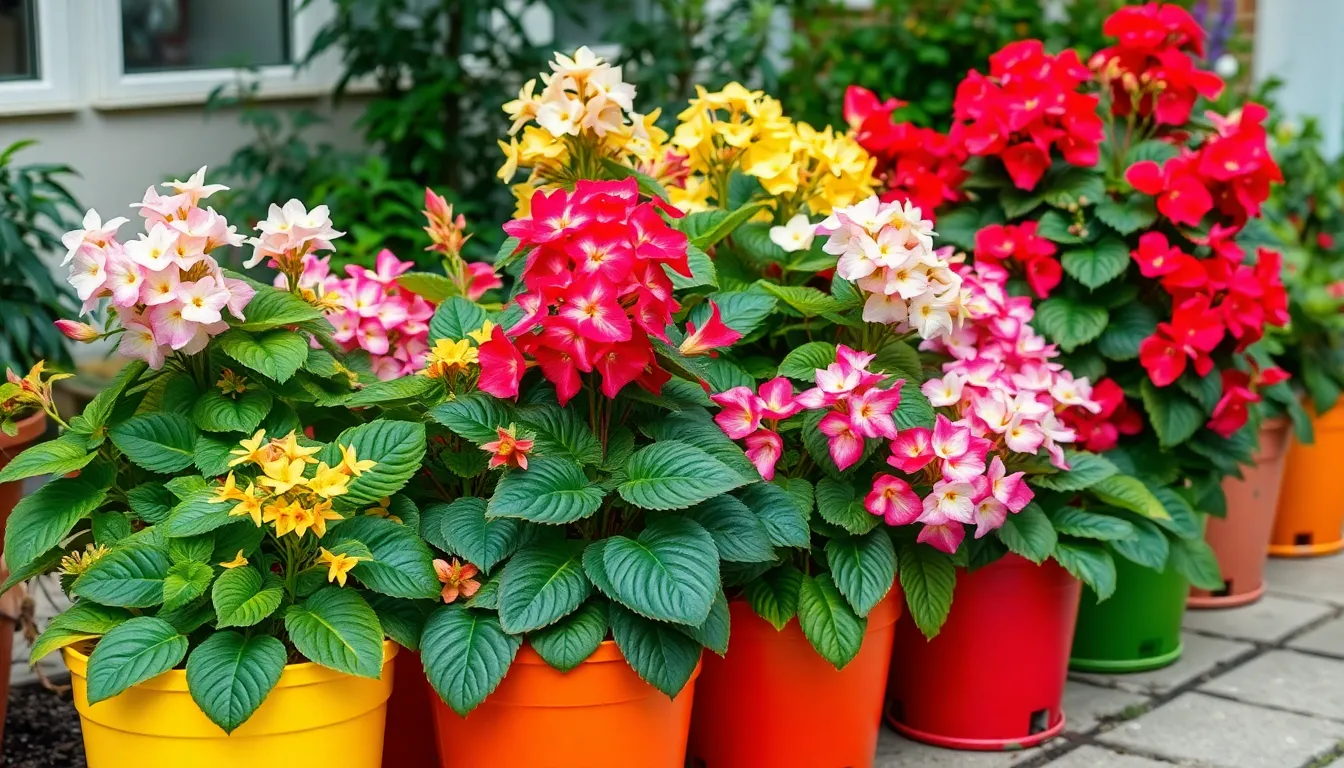
Begonias offer gardeners a reliable solution for maintaining vibrant color in areas that receive limited direct sunlight. These versatile plants deliver continuous flowering throughout the growing season, making them perfect companions for the shade loving plants we’ve already explored.
Tuberous vs Fibrous Begonia Options
Tuberous begonias showcase large, spectacular flowers that create dramatic focal points in shaded garden areas. We find these varieties particularly striking with their blooms reaching 4 to 6 inches across in brilliant shades of pink, white, and red. Storage requirements make tuberous types more demanding since their tubers need winter protection in cold climates.
Fibrous begonias produce smaller but more abundant flowers that bloom continuously from spring through frost. These compact plants rarely exceed 12 inches in height, making them ideal for edging shaded pathways or filling containers. Maintenance proves significantly easier with fibrous varieties since they can survive as annuals without special winter storage needs.
Growth habits differ substantially between these two begonia types. Tuberous varieties develop trailing stems that work beautifully in hanging containers, while fibrous begonias maintain neat, mounded shapes perfect for border plantings. We recommend fibrous begonias for beginning gardeners since they tolerate occasional watering lapses better than their tuberous counterparts.
Container Growing for Low Light Areas
Container growing maximizes begonia potential in spaces with challenging light conditions. We position portable containers to capture optimal morning light while protecting plants from harsh afternoon sun. This flexibility allows us to move begonias throughout the season to maintain ideal growing conditions.
Drainage becomes critical when growing begonias in containers since waterlogged soil quickly leads to root rot. We drill additional holes in container bottoms and add gravel layers to ensure excess water escapes freely. Quality potting mix designed for container plants provides the proper texture and nutrition begonias need.
Size considerations affect both plant health and visual impact in container displays. Standard 12 inch containers accommodate 3 to 4 fibrous begonias comfortably, while single tuberous begonias thrive in similar sized pots. We combine begonias with complementary shade plants like caladiums and small hostas to create layered container compositions.
Watering frequency increases in containers compared to ground plantings. Daily moisture checks prevent both drought stress and overwatering issues that commonly affect container grown begonias. We water early morning to allow foliage to dry before evening temperatures drop.
Extending the Blooming Season
Regular deadheading maintains continuous flower production throughout the growing season. We pinch spent blooms weekly, removing the entire flower stem back to the main branch to encourage new bud formation. This practice redirects plant energy from seed production into creating fresh flowers.
Fertilization schedules directly impact blooming duration and flower quality in begonias. Balanced liquid fertilizers applied every two weeks provide steady nutrition without promoting excessive foliage growth that reduces flowering. We reduce fertilizer strength by half during peak summer heat to prevent fertilizer burn.
Weather protection extends begonia blooming into late fall in many regions. Covering plants during unexpected cold snaps or providing temporary shade during heat waves prevents stress that interrupts flowering cycles. We use lightweight row covers or shade cloth to shield begonias from extreme conditions.
Pruning techniques help rejuvenate tired plants during mid season slowdowns. Light trimming of leggy stems encourages branching and fresh growth that produces new flower clusters. We avoid heavy pruning that removes too much foliage since begonias need their leaves for energy production.
Ferns: Ancient Plants Perfect for Modern Shade Gardens
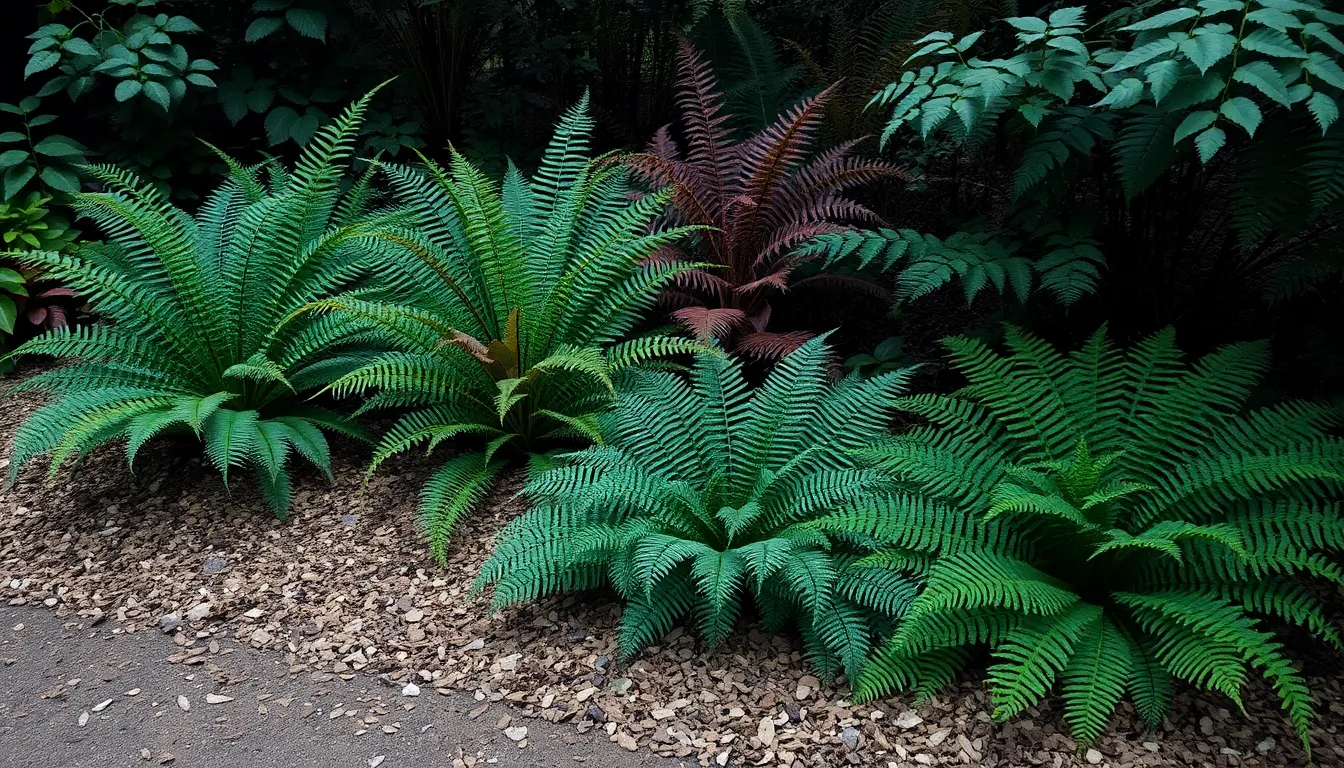
Ferns bring prehistoric elegance to contemporary shade gardens while requiring minimal maintenance once established. These resilient plants create lush green backdrops that complement flowering perennials and provide year-round structure to low-light areas.
Hardy Outdoor Fern Species
Lady Ferns top our list of reliable shade performers, producing fronds that start light green and gradually darken as they mature throughout the season. We’ve found these adaptable beauties thrive in various low-light conditions and establish quickly in most garden settings.
Autumn Ferns deliver exceptional hardiness with their copper-colored new growth that transitions to deep green as fronds age. These sturdy plants withstand temperature fluctuations better than many fern varieties and maintain their attractive appearance well into winter.
Holly Ferns provide evergreen structure with their glossy, leathery fronds that resist wind damage and harsh weather conditions. We recommend these robust plants for gardeners seeking low-maintenance options that look polished year-round.
Christmas Ferns offer reliable winter interest with their deep green fronds that remain attractive even under snow cover. These native species adapt well to various soil conditions and establish strong root systems that support long-term garden health.
Creating Natural Woodland Settings
Companion Plant Combinations work best when we pair ferns with shade-tolerant perennials like hostas, pulmonaria, and caladiums for layered texture effects. Strategic placement creates depth by positioning taller ferns as backdrop elements while shorter varieties fill foreground spaces.
Naturalistic Groupings emerge when we plant multiple fern species in irregular clusters rather than formal rows or geometric patterns. Mass plantings of three to five specimens create impactful visual statements that mimic forest floor conditions.
Transition Zones develop naturally when we use ferns to bridge areas between deep shade and partial sun locations in our gardens. These plants help create smooth visual flow from bright garden beds to shadier retreat spaces.
Seasonal Interest builds throughout the year as different fern species unfurl their fronds at varying times during spring and summer months. We’ve observed that staggered emergence periods extend the excitement of new growth from early spring through midsummer.
Moisture Requirements and Drainage
Soil Preparation begins with creating well-draining conditions that retain consistent moisture without becoming waterlogged or soggy. We recommend amending heavy clay soils with organic matter like compost or leaf mold to improve both drainage and water retention.
Watering Schedules should provide regular moisture during establishment periods, typically requiring deep weekly watering for the first growing season. Established ferns need less frequent but thorough watering, especially during dry summer periods.
Drainage Answers prevent root rot by ensuring water moves through the soil rather than pooling around plant crowns. We suggest raising planting beds slightly or adding coarse organic matter to improve soil structure in problematic areas.
Mulching Benefits help maintain consistent soil moisture while suppressing weeds that compete with shallow fern root systems. Organic mulches like shredded leaves or bark chips break down gradually and improve soil quality over time.
Impatiens: Reliable Bloomers for Low Light Outdoor Plants
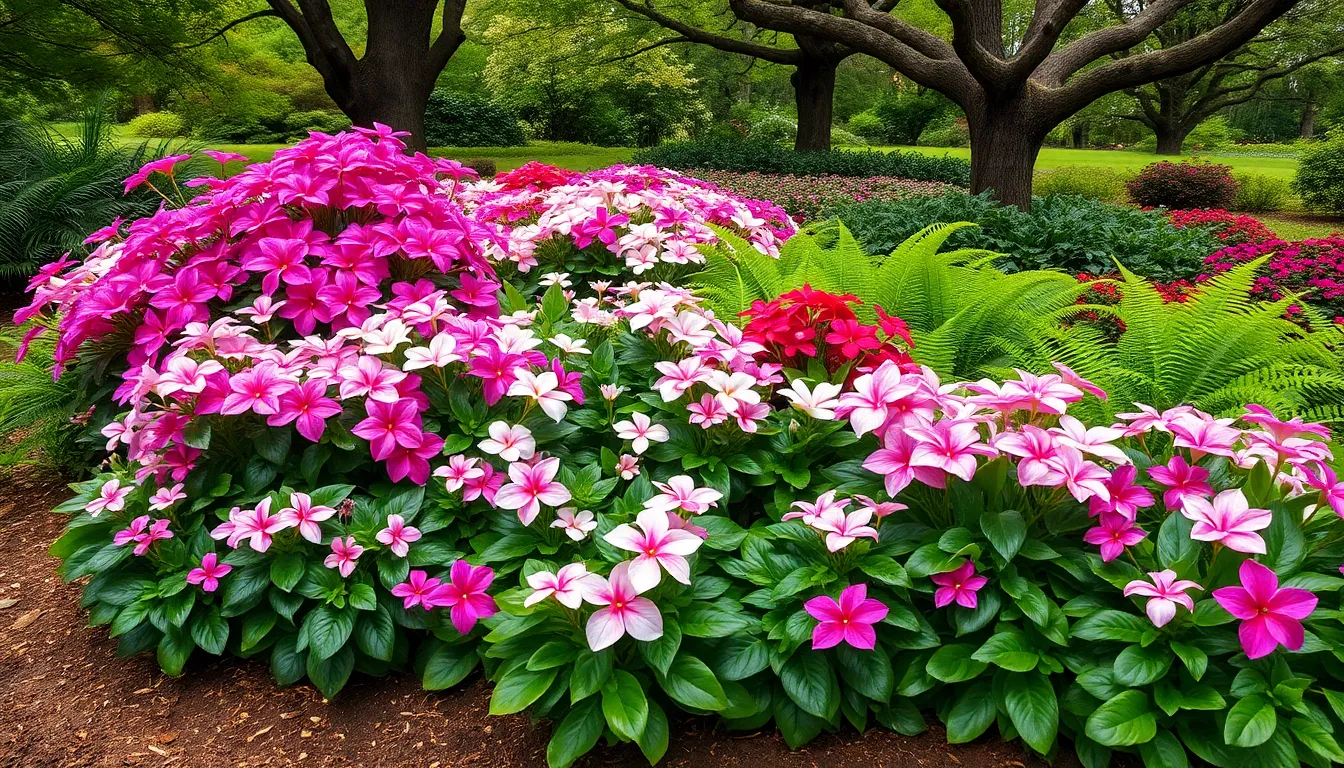
Impatiens stand out as one of our most dependable choices for bringing vibrant color to low light outdoor areas. These reliable bloomers thrive where many other flowering plants struggle, making them perfect companions to the ferns and shade perennials we’ve already explored.
New Guinea vs Standard Impatiens
New Guinea Impatiens deliver bold, dramatic blooms with their larger leaves and more vibrant flowers in stunning shades of pink, white, and purple. Their robust nature allows them to handle slightly more sun than their standard cousins while still performing exceptionally well in partial shade conditions. We recommend these varieties for areas that receive 2 to 4 hours of morning sunlight or filtered light throughout the day.
Standard Impatiens offer a more compact growth habit with smaller flowers available in an extensive color palette. These plants excel in areas receiving less than 4 hours of direct sunlight, making them ideal for deeper shade locations under mature trees or north facing foundations. Their prolific blooming nature creates dense carpets of color that complement the textural elements of hostas and ferns beautifully.
Both varieties maintain continuous blooms from spring through the first frost, providing the seasonal color consistency that makes them invaluable for low light garden design.
Disease Prevention and Plant Health
Well draining soil forms the foundation of healthy impatiens growth, preventing the root rot that commonly affects plants in moisture retentive conditions. We ensure proper drainage by amending heavy clay soils with compost or perlite before planting. Standing water around impatiens roots creates ideal conditions for fungal diseases that can devastate entire plantings.
Adequate spacing between plants promotes air circulation and prevents moisture accumulation on foliage, which reduces the risk of downy mildew. Plant impatiens 8 to 12 inches apart depending on the variety, allowing each plant room to develop its natural shape without crowding neighboring specimens.
Fungicide applications provide additional protection when environmental conditions favor disease development. Apply organic copper based fungicides or synthetic options according to package directions, focusing on preventive treatments rather than reactive applications. Regular monitoring for yellowing leaves or wilting symptoms allows for early intervention before diseases spread throughout the planting area.
Mass Planting Techniques
Border planting creates stunning color ribbons along garden edges, pathways, or foundation areas where impatiens can define spaces with continuous blooms. We plant them in sweeping curves rather than straight lines to achieve more natural looking displays that flow seamlessly with existing industry elements.
Massed ground cover installations transform large shaded areas into vibrant color carpets by planting impatiens densely across broad spaces. This technique works particularly well under mature tree canopies where grass struggles, creating living mulch that suppresses weeds while providing season long color.
Container garden combinations allow us to group impatiens with other shade loving plants like caladiums and begonias in large planters for portable color displays. These arrangements can be repositioned throughout the growing season to optimize light conditions or create focal points where permanent plantings aren’t practical.
Stagger planting times by 2 to 3 weeks to extend the blooming season and ensure continuous color replacement as older plants begin to decline in late summer heat.
Coleus: Vibrant Foliage Without Full Sun
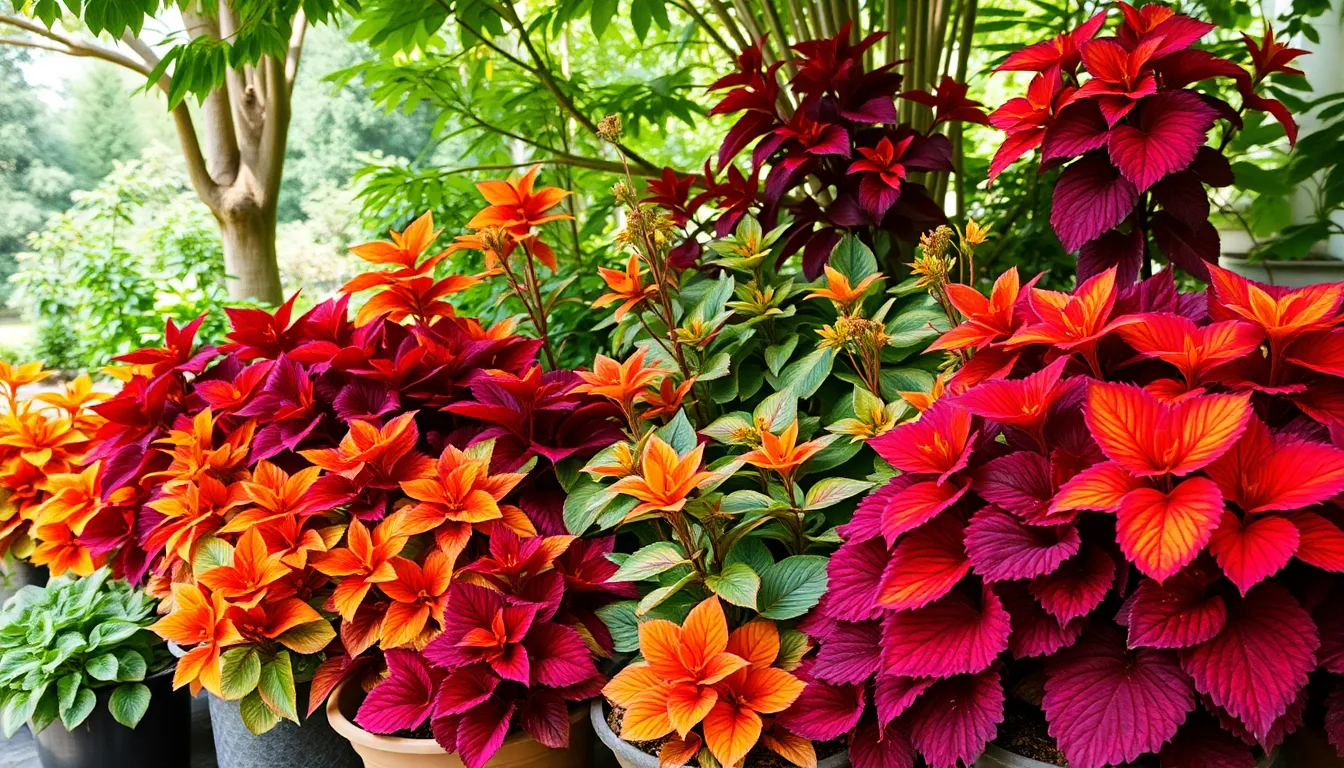
Coleus brings stunning color variations to shaded gardens where many flowering plants struggle to perform. These foliage powerhouses create dramatic displays even without the bright conditions typically associated with vibrant plant colors.
Heat-Tolerant Coleus Varieties
Heat tolerant coleus varieties adapt remarkably well to partial shade conditions while maintaining their striking foliage colors. We’ve found that these cultivars perform exceptionally in areas receiving morning sun followed by afternoon shade, making them perfect for transitional garden zones.
Premium heat resistant selections include varieties specifically bred to withstand challenging growing conditions:
- ‘Solar Flare’ produces bronze and red leaves that intensify in partial shade
- ‘Campfire’ displays orange and burgundy tones that remain vibrant in low light
- ‘Kong’ series offers oversized leaves in multiple color combinations
- ‘Wizard’ varieties maintain compact growth with reliable color performance
Weather resilient coleus types handle temperature fluctuations better than standard varieties, ensuring consistent garden performance throughout the growing season. These selections typically require 4 to 6 hours of filtered light rather than direct sun exposure.
Container grown coleus varieties offer flexibility for positioning in optimal light conditions throughout your garden space. Moving containers allows us to adjust placement based on seasonal light changes and plant performance needs.
Pinching and Pruning for Bushy Growth
Pinching encourages dense, compact growth that creates fuller plant displays in shaded garden areas. Regular maintenance keeps coleus plants from becoming leggy while promoting the lush foliage that makes these plants so attractive.
Essential pinching techniques maximize plant density and visual impact:
- Initial pinching should occur when plants reach 6 inches tall
- Flower spike removal redirects energy toward foliage production
- Side shoot pinching creates bushier growth patterns
- Regular maintenance every 2 to 3 weeks maintains plant shape
Pruning timing affects overall plant performance, with early morning sessions reducing stress on developing foliage. We recommend using clean, sharp tools to prevent disease transmission between plants.
Growth regulation through strategic pinching creates more attractive plant forms while extending the productive growing season. This technique works particularly well with coleus since these plants respond quickly to pruning with increased branching.
Overwintering Indoor Options
Overwintering coleus indoors extends the life of these colorful plants beyond their typical annual growing cycle. Bringing potted plants inside before first frost allows us to enjoy vibrant foliage throughout winter months.
Successful indoor transition requires exact environmental adjustments:
- Bright indoor locations near south facing windows provide adequate light
- Temperature maintenance between 65 to 75 degrees supports continued growth
- Humidity levels around 40 to 50 percent prevent leaf drop
- Reduced watering accommodates slower winter growth rates
Indoor coleus care differs significantly from outdoor requirements, with lower light levels affecting growth patterns and watering needs. We’ve observed that gradually reducing water frequency helps plants adjust to indoor conditions.
Propagation opportunities arise during overwintering periods, as healthy indoor plants produce cuttings for next season’s garden displays. Taking 4 to 6 inch stem cuttings in late winter ensures robust plants ready for spring transplanting.
Essential Care Tips for Low Light Outdoor Plants
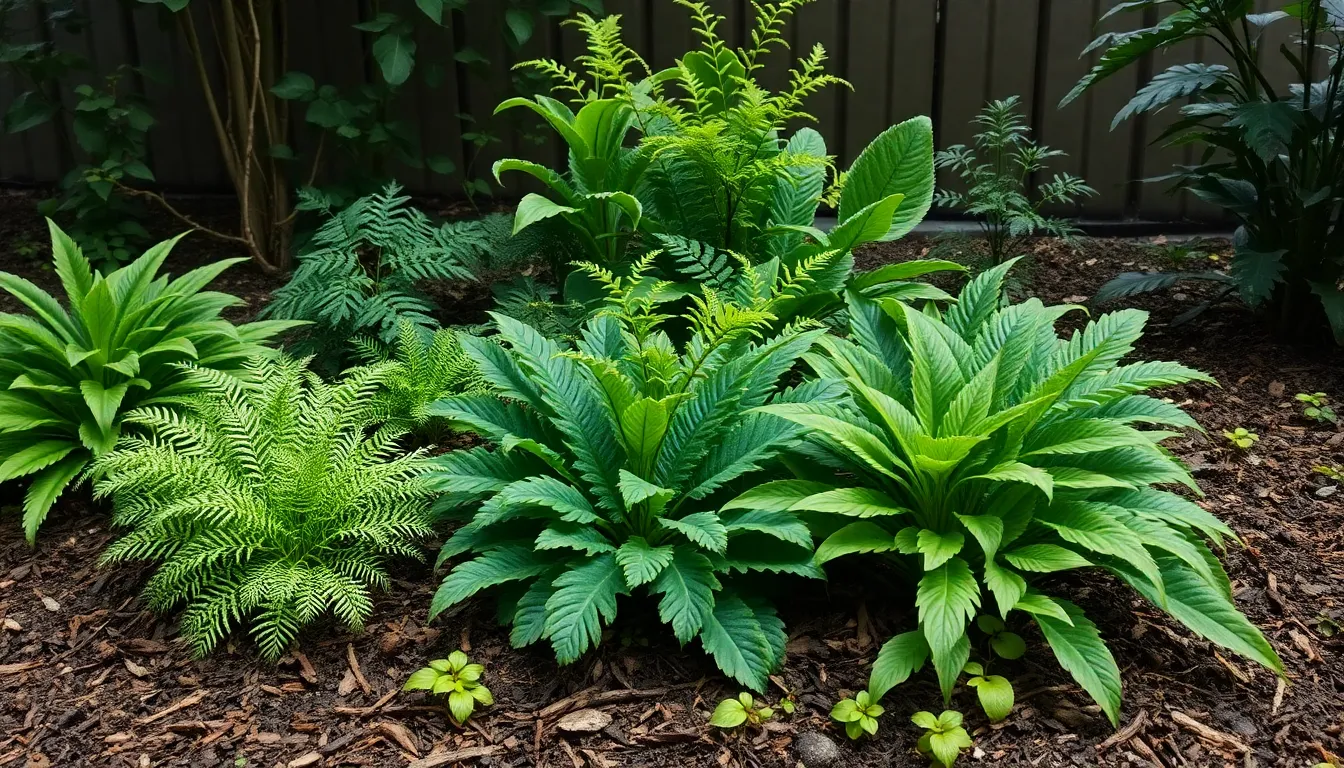
Success with shade-loving plants requires exact care techniques that differ from traditional sun garden approaches. Understanding these essential practices ensures your low light plants thrive throughout the growing season.
Soil Preparation and Amendment
Enriching your soil forms the foundation for healthy shade plants. Most low light varieties prefer rich, well-draining soil that retains moisture without becoming waterlogged. We recommend regularly adding compost or organic matter to improve soil fertility and structure, creating the ideal growing environment these plants need.
Mulching provides multiple benefits for shade garden success. Apply a 2-inch layer of organic mulch around your plants to conserve moisture, regulate soil temperature, and suppress weed growth. Quality mulch materials like shredded leaves, bark chips, or compost help maintain consistent soil conditions that shade plants love.
Testing your soil helps determine exact amendment needs. Check pH levels and drainage capacity before planting, as most shade varieties prefer slightly acidic to neutral soil conditions. Adding organic amendments improves both heavy clay and sandy soils, creating the balanced texture shade plants require.
Watering Schedules and Techniques
Consistent moisture levels keep shade plants healthy and vibrant. Most low light varieties prefer evenly moist soil conditions rather than the wet-dry cycles that some sun plants tolerate. We suggest checking soil moisture frequently and watering deeply when the top inch feels dry to the touch.
Assessing moisture levels prevents common watering mistakes. Always test soil moisture before watering, especially for plants like begonias and impatiens that are susceptible to root rot. Stick your finger 1-2 inches into the soil near the plant base to gauge moisture content accurately.
Proper watering techniques support optimal plant health. Water at the soil level rather than overhead to reduce disease risk and ensure water reaches the root zone effectively. Early morning watering allows plants to absorb moisture before the day’s heat while reducing fungal problems common in shaded areas.
Fertilizing Shade-Loving Plants
Balanced fertilizers support steady growth in low light conditions. Use organic, balanced fertilizers to nourish your shade plants without overwhelming them with excessive nutrients. We recommend applying fertilizer in early spring and again in mid-summer to align with natural growth patterns.
Biweekly fertilization schedules work well for many shade gardens. Since plant metabolic demands are lower in shaded environments, lighter but more frequent feeding often produces better results than heavy seasonal applications. This approach provides steady nutrition without encouraging excessive foliage growth that weakens plants.
Avoiding over-fertilization protects plant health and longevity. Follow exact recommendations for each plant species rather than using generic feeding schedules, as shade plants typically require less fertilizer than their sun-loving counterparts. Too much fertilizer can create weak, disease-prone growth and reduce the natural resilience these plants are known for.
Conclusion
We’ve shown you that low-light areas don’t have to be gardening dead zones. From the reliable foliage of hostas to the vibrant blooms of begonias these shade-loving plants offer endless possibilities for creating stunning outdoor spaces.
Success with low-light plants comes down to understanding your exact conditions and choosing the right varieties for your space. Whether you’re working with deep shade under mature trees or partial shade along north-facing walls there’s always a perfect plant combination waiting to transform your garden.
Remember that proper soil preparation consistent watering and strategic plant placement will help your shade garden thrive for years to come. Start with one or two varieties that appeal to you and gradually expand your collection as you gain confidence in shade gardening.
Frequently Asked Questions
What types of shade exist in gardening?
There are three main types of shade: partial shade (3-6 hours of direct sunlight daily), full shade (less than 3 hours of direct sun), and deep shade (no direct sunlight). You can measure light levels using light meters or smartphone apps. Common low-light areas include spaces under mature trees, north-facing foundations, between buildings, covered patios, and woodland edges.
Which plants are best for low-light outdoor gardens?
Popular low-light plants include hostas (classic shade perennials with varieties like ‘Golden Tiara’ and ‘Patriot’), astilbe (feathery plume flowers), heuchera/Coral Bells (colorful foliage), caladiums (vibrant tropical leaves), begonias (continuous blooms), ferns (elegant ancient plants), impatiens (reliable bloomers), and coleus (striking foliage colors). Each offers unique benefits for shaded spaces.
How do I care for hostas in low-light conditions?
Hostas thrive with proper soil preparation, consistent watering, and sun protection. Plant them in well-draining, organic-rich soil and maintain steady moisture levels without waterlogging. They provide seasonal interest through diverse foliage colors and summer flower spikes. Popular varieties include ‘Golden Tiara,’ ‘Patriot,’ and various blue-leafed cultivars that excel in shaded areas.
What makes astilbe a good choice for shade gardens?
Astilbe produces beautiful plume-like flowers and delicate foliage in low-light conditions. Top varieties include ‘Rheinland,’ ‘Fanal,’ and ‘Pumila,’ each offering different colors and heights. They require consistent moisture and well-draining soil with organic amendments. Astilbe pairs beautifully with hostas, heucheras, and ferns for stunning color combinations throughout the growing season.
How do I maintain vibrant begonias in shaded areas?
Begonias provide continuous blooms in low light. Tuberous varieties produce large, dramatic flowers but need winter protection, while fibrous types are easier to maintain. Ensure proper drainage, consistent watering, and regular deadheading. Container growing works well for begonias, allowing optimal placement and easier care management while maintaining vibrant colors throughout the season.
What are the best ferns for low-light gardens?
Hardy fern species perfect for shade include Lady Ferns, Autumn Ferns, Holly Ferns, and Christmas Ferns. Each offers unique characteristics and requires minimal maintenance. Ferns thrive with proper soil preparation, consistent moisture, and mulching. They create elegant naturalistic groupings and work excellently as companion plants with other shade-tolerant perennials for sophisticated garden designs.
How do I prepare soil for low-light plants?
Enrich soil with organic matter like compost or aged manure to improve drainage and fertility. Test soil pH and drainage needs, then apply 2-4 inches of mulch to conserve moisture and suppress weeds. Most shade plants prefer slightly acidic to neutral soil (pH 6.0-7.0). Proper soil preparation is crucial for establishing healthy root systems in low-light conditions.
What watering schedule works best for shade plants?
Maintain consistent moisture levels without waterlogging. Shade plants typically need less frequent watering than sun plants since they lose less water to evaporation. Water deeply but less frequently to encourage deep root growth. Check soil moisture regularly and adjust based on rainfall, temperature, and plant needs. Mulching helps retain soil moisture between waterings.

